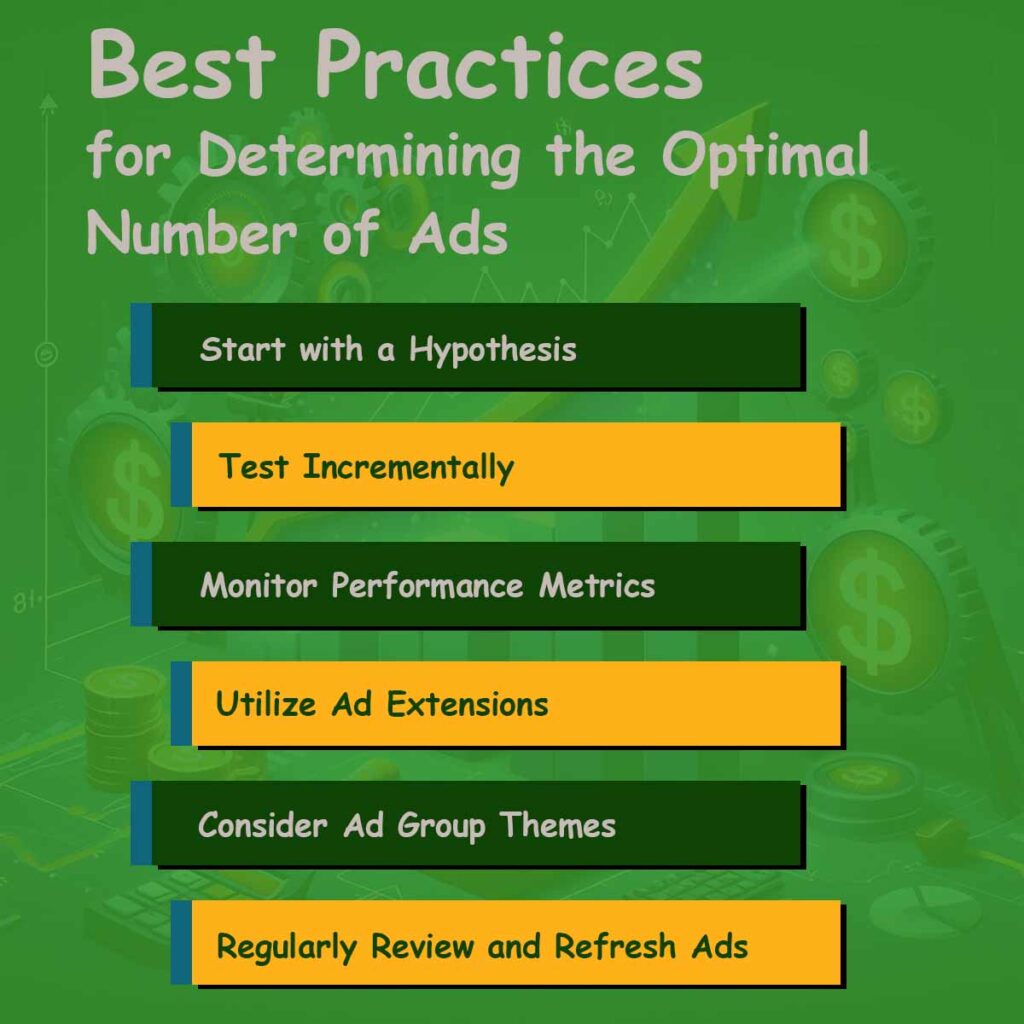How Many Ads Should Be Implemented Per Ad Group? - NSK MultiServices

Creating valuable content for digital ads is crucial for success. One key question is how many ads to implement per ad group. This guide explores the factors and tactics to help you decide the ideal number of ads, aiming to amplify your advertising ROI.
1) Importance of Ad Group Structure
Before delving into the “How Many Ads Should Be Implemented Per Ad Group”, it’s essential to understand the significance of ad group structure within digital advertising campaigns.
Ad groups serve as organizational units that contain a set of ads and keywords with a common theme or target audience.
Structuring ad groups thoughtfully allows advertisers to create highly relevant ads that resonate with specific audience segments, thereby improving ad relevance, quality score, and ultimately, campaign performance.
Also Read : PPCExpo recommends implementing 3 to 5 ads per Ad Group. Learn more by reading here.
Related Articles
- SEO Tips for Google My Business to improve Ranking
- Google Ads Ranking Factors: A Comprehensive Guide
- How can Google Ads help you advance your Business Goals?
- Digital Marketing Portfolio
- The Comprehensive Google Ads Optimization Checklist: Boost Your Campaigns
.
2) Factors Influencing the Number of Ads per Ad Group
3.1) Campaign Objectives
The number of ads you should implement per ad group largely depends on your campaign objectives. When setting out to create an ad campaign, defining clear and measurable objectives is the foundational step.
These objectives could range from increasing brand awareness to driving sales or generating leads. The choice of how many ads to include in each ad group is intricately tied to these objectives and the underlying strategy devised to achieve them.
3.1.1) A/B Testing and Message Variation
For instance, if your goal is to test multiple messaging variations to identify the most effective ones, you might opt for a larger number of ads per group. This approach allows for comprehensive A/B testing, where different ad copies, headlines, descriptions, and visuals can be experimented with simultaneously.
By exposing your audience to various messaging variations, you can gather valuable insights into what resonates best with them, ultimately leading to improved ad performance and higher conversion rates.
In this scenario, diversity in ad creatives within the ad group facilitates thorough testing, enabling marketers to refine their messaging based on real-time data and feedback.
3.1.2) Focus and Message Consistency
Conversely, if your aim is to maintain a tight focus on a specific message or offer, fewer ads might suffice. In cases where the campaign strategy revolves around promoting a single product or highlighting a specific value proposition, streamlining the number of ads within each ad group can help maintain clarity and consistency in messaging.
By limiting the variations, you ensure that the audience receives a unified and impactful message, minimizing the risk of diluting the campaign’s core objective.
This focused approach is particularly beneficial when targeting niche audiences or when aiming to drive immediate action, as it eliminates distractions and directs the audience’s attention towards the desired call-to-action.
3.2) Budget and Resources
Consider the resources at your disposal, including budget and manpower. When determining the number of ads to implement per ad group, it’s essential to assess your available resources and allocate them effectively to maximize the impact of your advertising efforts.
Managing a large number of ads can be resource-intensive, requiring significant time and effort for monitoring, optimization, and analysis.
3.2.1) Resource Allocation
Your budget plays a pivotal role in dictating the scale and scope of your advertising campaigns. Allocating a substantial portion of your budget towards ad creation and management allows for a more extensive ad inventory per ad group.
Conversely, limited budgets may necessitate a more selective approach, prioritizing the creation and optimization of a smaller number of high-performing ads.
3.2.2) Manpower Considerations
In addition to budgetary constraints, consider the human resources available for managing your ad campaigns. Effective ad management involves tasks such as crafting ad copy, monitoring performance metrics, conducting A/B tests, and making data-driven optimizations.
Depending on the size of your marketing team and their expertise, managing a large number of ads across multiple ad groups may require significant manpower and expertise.
3.2.3) Time and Effort Investment
Managing numerous ads within each ad group entails ongoing time and effort investment. From creating compelling ad creatives to analyzing performance data and adjusting ad strategies accordingly, each step in the advertising process demands careful attention and dedication.
Therefore, it’s essential to assess whether your team has the bandwidth to effectively manage the desired number of ads per ad group without sacrificing quality or efficiency.
3.2.4) Optimization Opportunities
While a larger number of ads can provide more opportunities for optimization and testing, it’s essential to strike a balance between quantity and quality.
Investing resources in creating a manageable number of high-quality ads allows for more focused optimization efforts, ensuring that each ad receives the attention it deserves to drive optimal results.
3.2.5) Scaling Strategies
As your budget and resources grow, you may explore scaling strategies to increase the number of ads per ad group gradually. This incremental approach allows for controlled expansion, enabling you to gauge the impact of additional ads on campaign performance and adjust your strategy accordingly.
By scaling strategically based on performance insights and resource availability, you can optimize your ad campaigns for maximum efficiency and effectiveness.
3.3) Audience Segmentation
Segmenting your audience based on demographics, interests, or buying behavior is a fundamental strategy for effective advertising.
By dividing your target audience into distinct segments, you can tailor your messaging and creative elements to resonate with specific groups more effectively.
This segmentation process not only enhances the relevance of your ads but also informs the number of ads needed per ad group.
3.3.1) What is Audience Diversity
Audience segmentation acknowledges that not all consumers are alike. Individuals within your target audience may vary in terms of age, gender, geographic location, interests, preferences, and purchasing behavior.
Recognizing these differences allows you to create more personalized and targeted advertising campaigns that speak directly of the unique needs and preferences of each segment.
3.3.2) Tailored Messaging for Each Segment
Different audience segments may respond differently to messaging and creative elements. For example, a young, tech-savvy audience may prefer concise, visually appealing ads with trendy language, while an older demographic may respond better to more traditional messaging styles.
By segmenting your audience and understanding their preferences, you can tailor your ad content to resonate with each segment more effectively.
3.3.3) Importance of Multiple Ads per Group
Given the diversity within your target audience, a one-size-fits-all approach to advertising is often ineffective. Instead, adopting a more tailored approach with multiple ads per group allows you to cater to diverse preferences and increase the likelihood of resonating with different segments. Each ad within the group can be designed to appeal to a specific subset of your audience, addressing their unique needs, pain points, and motivations.
3.3.4) Adapting to Audience Preferences
Audience segmentation is not a static process; consumer preferences and behaviors evolve over time. Therefore, it’s essential to continually monitor and analyze audience data to identify shifts in preferences and adjust your ad strategy accordingly. By staying attuned to your audience’s changing needs, you can ensure that your advertising remains relevant and impactful.
3.3.5) Testing and Optimization
Implementing multiple ads per ad group also provides opportunities for testing and optimization. By experimenting with different messaging variations, visuals, and offers, you can gather valuable insights into what resonates best with each audience segment. A/B testing allows you to compare the performance of different ad variations and refine your strategy based on data-driven insights, ultimately improving campaign effectiveness and ROI.
3.4) Ad Testing Strategy
If your strategy involves rigorous A/B testing of ad variations to optimize performance, you’ll likely want to implement a larger number of ads per ad group. A robust ad testing strategy is instrumental in fine-tuning your campaigns and maximizing their effectiveness. By implementing a diverse array of ad variations within each ad group, you create ample opportunities to experiment with different elements such as headlines, descriptions, calls-to-action (CTAs), visuals, and even ad formats.
3.4.1) Comprehensive A/B Testing
A larger number of ads per ad group allows for comprehensive A/B testing, where multiple variables are systematically tested to identify winning combinations that drive the highest click-through rates (CTR) and conversions. Through rigorous experimentation, you gain valuable insights into which ad elements resonate most effectively with your target audience, enabling you to refine your messaging and optimize campaign performance accordingly.
3.4.2) Headline Variations
Testing different headline variations enables you to assess the impact of varying messaging on audience engagement and ad performance. Whether you’re testing different value propositions, offers, or hooks, analyzing the performance of each headline variation provides valuable insights into what captures the attention of your audience and prompts them to take action.
3.4.3) Description Testing
Similarly, experimenting with different ad descriptions allows you to refine your messaging and convey your value proposition more effectively. By testing variations in language, tone, and length, you can identify which descriptions resonate best with your audience and compel them to click through to your landing page or website.
3.4.4) CTA Optimization
The call-to-action (CTA) is a critical element of any ad, as it prompts the audience to take the desired action. Testing different CTAs allows you to assess which prompts generate the highest conversion rates and drive desired outcomes, whether it’s making a purchase, signing up for a newsletter, or downloading an app.
3.4.5) Visual Experimentation
Incorporating visual elements such as images, videos, or graphics into your ads offers another dimension for experimentation. Testing different visual elements enables you to gauge their impact on ad engagement and conversion rates, helping you identify the most compelling visuals that resonate with your audience and effectively communicate your message.
3.4.6) Ad Format Testing
Beyond individual ad elements, testing different ad formats can also yield valuable insights into audience preferences and behavior. Whether you’re experimenting with text ads, display ads, responsive ads, or video ads, assessing the performance of each format allows you to optimize your ad mix and allocate resources towards the most effective formats for achieving your campaign objectives.
3.5) Ad Rotation Settings
Consider the ad rotation settings within your advertising platform as they play a important role in determining the number of ads per ad group. Ad rotation settings dictate how ads within a group are displayed to users, influencing the distribution of impressions and clicks among different ad variations. Depending on whether you opt for evenly rotating ads or prioritize those with higher performance, you may adjust the number of ads per group accordingly.
3.5.1) Ad Rotation Strategies
- Even Rotation: With even rotation, the advertising platform distributes impressions evenly across all ads within the ad group. This approach is ideal for conducting A/B tests and gathering performance data on multiple ad variations simultaneously. By rotating ads evenly, you ensure that each ad receives equal exposure, allowing for a fair comparison of their effectiveness in achieving campaign objectives.
- Optimize for Clicks or Conversions: Alternatively, you may choose to prioritize ads based on their performance metrics such as clicks or conversions. In this case, the advertising platform will automatically favor ads that have demonstrated higher click-through rates (CTR) or conversion rates, optimizing the ad rotation to maximize engagement and conversion opportunities. By focusing resources on top-performing ads, you can allocate budget and attention more effectively, enhancing campaign efficiency and ROI.
3.5.2) Impact on Number of Ads per Group
The choice of ad rotation settings can influence the number of ads you decide to implement per ad group. If you prioritize top-performing ads for optimization, you might opt for fewer ads per group to focus resources on the most promising creatives. By concentrating efforts on a select number of high-performing ads, you streamline the optimization process and ensure that budget and manpower are directed towards maximizing the impact of your top-performing creatives.
Conversely, if you prefer to conduct extensive A/B testing and gather insights on multiple ad variations, you may choose to implement a larger number of ads per group and rotate them evenly. This allows for comprehensive testing of different messaging, visuals, and calls-to-action, enabling you to identify the most effective ad elements and refine your campaign strategy accordingly.
3.6) Continuous Optimization
Regardless of the ad rotation strategy chosen, continuous optimization is key to maximizing campaign performance. Regularly monitor the performance metrics of your ads, analyze the data, and make informed adjustments to your ad rotation settings and creative elements. By iterating and refining your ad strategy based on real-time insights, you can enhance ad relevance, engagement, and conversion rates over time, driving improved results and ROI for your advertising campaigns.
4) Best Practices for Determining the Optimal Number of Ads

- Start with a Hypothesis: Before launching your campaigns, formulate a hypothesis regarding the number of ads per ad group based on your objectives, audience insights, and testing strategy. This hypothesis will serve as a guiding framework that you can refine based on real-time performance data.
- Test Incrementally: Avoid overwhelming yourself with too many ads right from the start. Begin with a manageable number of ads per ad group and gradually scale up as you gather performance insights and refine your creative assets. Incremental testing allows you to iterate and optimize without spreading your resources too thin.
- Monitor Performance Metrics: Keep a close eye on key performance metrics such as CTR, conversion rate, and cost per acquisition (CPA) for each ad within your ad groups. Analyzing performance data will reveal which ads resonate with your audience and drive desired outcomes, helping you identify areas for improvement and optimization.
- Utilize Ad Extensions: Ad extensions can enhance the visibility and relevance of your ads by providing additional information such as links to specific pages, callouts, and structured snippets. Leveraging ad extensions strategically can augment your ad messaging without overcrowding your ad groups with excessive ads.
- Consider Ad Group Themes: Ensure that each ad group has a clear and coherent theme or focus. Avoid diluting the effectiveness of your ads by cramming too many disparate messages into a single ad group. Instead, maintain a tight thematic relevance that aligns with the intent and interests of your target audience.
- Regularly Review and Refresh Ads: Ad fatigue is a common challenge in digital advertising, wherein audiences become accustomed to seeing the same ads repeatedly, leading to diminished engagement over time. To combat ad fatigue, refresh your ad creative periodically and introduce new variations to keep your audience engaged and interested.
5) FAQs – Frequently Asked Questions
Why is ad group structure important in digital advertising?
Ad group structure ensures relevance and improves campaign performance by grouping ads and keywords with a common theme or target audience.
What factors influence the number of ads per ad group?
Campaign objectives, budget, audience segmentation, and testing strategy all influence the optimal number of ads to implement per ad group.
How does budget affect the number of ads per ad group?
Budget constraints may limit the number of ads you can effectively manage within each ad group, impacting resource allocation and campaign scalability.
Why is audience segmentation essential in determining ad quantity?
Segmenting your audience allows for more targeted messaging, influencing the number of ads needed to cater to diverse preferences and behaviors.
What is the role of A/B testing in determining ad quantity?
A/B testing helps identify the most effective ad variations, influencing the number of ads per group to facilitate comprehensive testing and optimization.
How do ad rotation settings impact ad quantity decisions?
Ad rotation settings dictate how ads are displayed, affecting the distribution of impressions and clicks among different ad variations and influencing the number of ads per group.
What are the benefits of prioritizing top-performing ads?
Prioritizing top-performing ads allows for focused optimization efforts, maximizing the impact of high-performing creatives and improving campaign efficiency.
How does incremental testing help determine the optimal number of ads?
Incremental testing allows for gradual scaling and refinement of ad strategies based on performance insights, ensuring effective resource allocation and campaign optimization.
Why is it important to monitor performance metrics when determining ad quantity?
Monitoring performance metrics provides valuable insights into ad effectiveness, informing decisions on ad quantity and facilitating continuous optimization for improved campaign performance.
What are some best practices for determining the optimal number of ads per ad group?
Best practices include starting with a hypothesis, testing incrementally, monitoring performance metrics, utilizing ad extensions, maintaining thematic relevance, and regularly refreshing ads to combat ad fatigue.
Conclusion
Determining the optimal number of ads to implement per ad group is a nuanced process that hinges on various factors including campaign objectives, budget, audience segmentation, and testing strategy. While there’s no definitive answer that applies universally, marketers can leverage a combination of strategic planning, incremental testing, and performance analysis to find the perfect balance. By continually refining ad group structures, monitoring performance metrics, and adapting to evolving audience preferences, advertisers can maximize the effectiveness of their digital advertising campaigns and achieve their desired outcomes.
About
Nandeshwar
Nandeshwar is a versatile professional skilled in digital marketing and App/Web development. With 5 years of experience and a Diploma in Computer Engineering, they excel in crafting effective marketing strategies and building dynamic websites. Specializing in content marketing, they drive results for clients while creating visually stunning websites using WordPress, Laravel, PHP and Flutter. Beyond work, they stay updated on industry trends and enjoy sharing insights.



